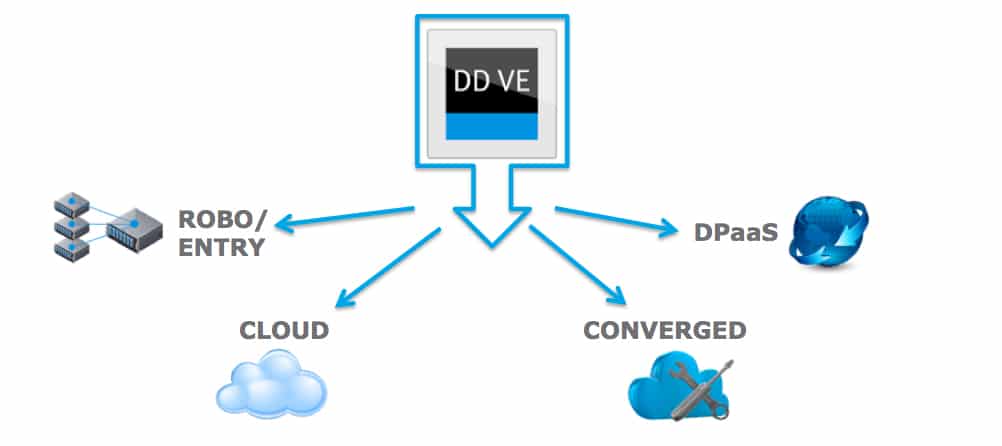Today at Dell EMC World 2016, Dell EMC announced that it would be enhancing data protection software and servers of both legacy companies that now make up the one new one by combining technologies. Along with further integration of the two companies to leverage each others technology benefits, Dell EMC is also announcing new cloud-enabled software updates to protect customers data (regardless of size of the customer or its data) in the modern data center. These data protection enhancements include the latest version of Data Domain Virtual Edition, version 3.0.

Since finalizing their acquisition, Dell EMC has been working on integrating the two technologies of the formally different companies. The combined technologies and services not only streamlines Dell EMC, it will also bring greater value to its customers and help them accelerate innovation. Not only is there a technological benefit of the two companies combining, now they can leverage their worldwide supply chain to lower costs for customers and become a single vendor that supplies end-to-end enterprise solutions.
Organizations now have applications and data both on-premises, off-premises, and in the cloud. IT now has to protect data wherever it resides. Dell EMC is working on cloud enabling its entire data protection portfolio across all workloads. To further address this, Dell EMC released version 3.0 of its Data Domain Virtual Edition (DD VE). DD VE, which runs as a virtual machine (VM), can now run on Dell EMC PowerEdge servers. Coming on the heels of DD VE being supported on Dell EMC VxRail appliances, Dell EMC is announcing that it is offering a pre-validated, fully supported, pre-tested reference architectures that combines PowerEdge 13G servers with DD VE software.
The latest version of DD VE features a handful of enhancements including a 6x increase in scalability and capable of protecting up to 96TB in a single instance. Customers are now able to run DD VE as a VM on either VMware vSphere or Microsoft Hyper-V. And customers are now able to leverage the recently announced cloud tiering capabilities for long-term data retention.
Aside from DD VE Edition 3.0, Dell EMC is also releasing new, as well as beefing up existing, cloud data protection and manageability. Dell EMC has enabled its data protection portfolio to provide its enterprise-grade protection to even more cloud platforms. To do this, Dell EMC is announcing two new data protection solutions as well as a slew of enhancements for existing solutions.
New data protection solutions and enhancements include:
- Protection of applications running on Microsoft Azure: Following the announcement of a protection solution for Amazon AWS at EMC World in May, NetWorker with CloudBoost now protects applications running on the Microsoft Azure platform, employing the same source-side data de-duplication, compression and encryption for highly efficient and secure backups in the cloud
- Native cloud tiering in NetWorker 9.1 and Avamar 7.4: Native administration of Data Domain Cloud Tier via the NetWorker or Avamar management consoles allows you to create, control and manage long-term data retention and data movement policies using Data Domain Cloud Tier from the same user interface being used for on-premises data retention workflows.
- Native cloud tiering for applications: With Data Domain Boost for Enterprise Applications, IT application administrators are now empowered to perform their own backup to the cloud for long-term retention, all while using their own application’s native interface or CLI commands. Supported applications include Oracle, SQL, SAP, SAP HANA, IBM DB2
- Natively tier de-duplicated data directly to cloud platforms: Data Domain Cloud Tier requires no cloud gateway or virtual appliance to tier de-duplicated data directly to the public, private or hybrid cloud. To further lower TCO, the solution ensures that only unique data is uploaded to already de-duplicated data within cloud object storage
- Secure data tiering to a variety of cloud platforms: Data Domain Cloud Tier supports data tiering to clouds including Virtustream Storage Cloud, Dell EMC ECS for on-premise object storage as well as third party public clouds and employs DD Encryption and DD Retention Lock to ensure data in the cloud remains secure
- Spanning Backup – Global Expansion: Microsoft Office 365 and SalesForce.com have become staple cloud-based business applications for office workers around the globe. Spanning Backup for Office 365 now simplifies compliance with European Union data sovereignty regulations, offering EU customers a backup and recovery solution for their cloud-based Office 365 and SalesForce data. All European customer data storage and processing is handled within a new regional data center located in the EU. Spanning, a Dell EMC company, intends to extend these services to other regions in 2017.
Availability
Data Domain Virtual Edition 3.0 and NetWorker 9.1 support for Microsoft Azure is available now. NetWorker 9.1 with CloudBoost is expected to be available in December 2016. Native management of Data Domain Cloud Tier support with NetWorker 9.1, Avamar 7.4, and Data Domain Boost for Enterprise Applications 3.5 is expected to be available in December. Spanning Backup for Office 365 service is available now.




 Amazon
Amazon